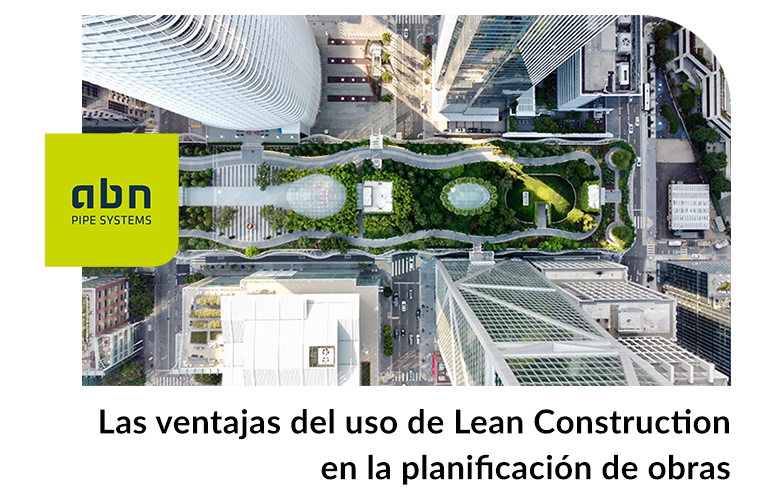En la búsqueda de la eficiencia y, sobre todo, de una construcción sostenible, son muchas las innovaciones que, desde otros sectores como, por ejemplo, el de la automoción, se están adaptando e implementando como metodologías de trabajo en obras gracias a su poder para una optimización de recursos y un trabajo más eficaz.
Una de las técnicas que se ha extendido más rápido es la Lean Construction ya que elimina los procesos que no agregan valor al producto final, evitando la pérdida de útiles, tiempo y mano de obra.
¿Qué es la metodología Lean Construction?
Lean Construction es una técnica de gestión que busca proporcionar valor y beneficios al cliente en la planificación de proyectos de construcción a través de procesos optimizados, aplicando una mejora continua.
El origen del sistema de trabajo Lean surge en Japón en los años 50 de la mano de Toyota, como alternativa a la producción en masa que imperaba en EE. UU. El Toyota Production System aboga por la producción ajustada ―Lean Manufacturing―, es decir, que no produce más de lo que demanda el mercado y busca reducir las pérdidas, entendidas como aquello que consume recursos y no agrega valor al producto final.
Esta filosofía aplicada a la construcción adopta los principios de esta filosofía para optimizar los procesos constructivos y conseguir los mejores resultados con la máxima eficiencia, o lo que es lo mismo, ofrecer un producto de la máxima calidad con menor coste y en menos tiempo.
La filosofía de la construcción eficiente
En ocasiones el éxito o fracaso de un proyecto depende de la gestión de la ejecución de la obra. Por ello, para amortiguar posibles problemáticas y el desperdicio de recursos, se tienen en cuenta 5 principios.
- Desarrollar ventajas competitivas, sumando valor a la construcción: Antes de iniciar el proyecto es fundamental tener una comprensión clara de las necesidades del cliente, por ello, todos los involucrados en el trabajo deben participar en reuniones de alineación para conocer en profundidad las necesidades de cada proyecto.
- Emplear procesos estandarizados para la planificación: Aunque cada proyecto tiene sus peculiaridades y es casi imposible escapar de imprevistos, siempre es posible adoptar patrones de trabajo que reduzcan la variación entre un proyecto y otro.
- Eliminar los flujos de trabajo que no aporten valor: A través de este principio se busca optimizar el proceso de construcción y ajustar tiempos.
- Realizar una gestión transparente de la construcción: Esto facilita la identificación de posibles errores, ya que así toda la información necesaria se encuentra siempre disponible.
- Entregar el trabajo en un plazo corto de tiempo: Gracias a tener empleados enfocados en tareas específicas y contar con una estimación más precisa de los pasos del trabajo.
Problemas a los que se enfrenta la Lean Construction
El sector de la construcción siempre ha sido muy tradicional y bastante sensible a nuevos cambios o nuevas formas de gestión. Con el tiempo esta situación ha provocado que las obras, y en general, todo proceso constructivo, tenga deficiencias importantes en muchos aspectos y que, además, se repiten constantemente, como son:
- El desperdicio de recursos: La construcción es conocida por su alto nivel de desperdicio de materiales, tiempo y dinero.
- Los retrasos en el cronograma: Los proyectos de construcción suelen experimentar retrasos en el cronograma debido a una planificación deficiente, cambios de última hora y problemas imprevistos en el sitio.
- Los costes excesivos: Los proyectos de construcción a menudo superan su presupuesto inicial debido a gastos inesperados y cambios en el diseño.
- La falta de calidad: Los defectos y problemas de calidad en la construcción pueden ser costosos y llevar a litigios.
- La dificultad de comunicación: La falta de comunicación efectiva entre los miembros del equipo de construcción puede dar lugar a malentendidos, conflictos y errores costosos.
- La baja productividad: La productividad en la construcción a menudo es baja debido a la falta de planificación y la ineficiencia en los procesos.
- La seguridad en el lugar de trabajo: Los accidentes en el lugar de trabajo son un problema importante en la construcción.
- La insatisfacción del cliente: Se trata de una cuestión común en la construcción cuando los proyectos no se completan a tiempo, dentro del presupuesto o con la calidad esperada.
Como aplicar la Lean Construction en la planificación de obras
Para implementar eficazmente esta metodología es importante prestar atención a sus principios de trabajo, que son los que nos proporcionan las siguientes claves:
- Tener una buena planificación, asegurando la buena estructura de las etapas de trabajo, con predicción de posibles imprevistos y una guía de gestión para situaciones de crisis.
- Invertir en mano de obra cualificada, reduciendo tiempos y ganando calidad gracias a equipos comprometidos y capacitados.
- Delegar tareas en las plataformas tecnológicas, automatizando tareas y previniendo riesgos permitiendo mejorar mejorando todos los pasos del trabajo.
